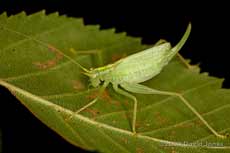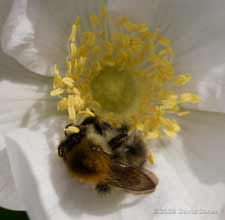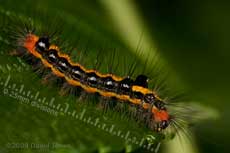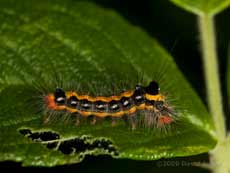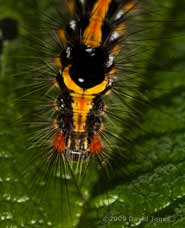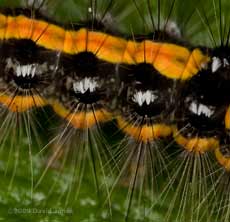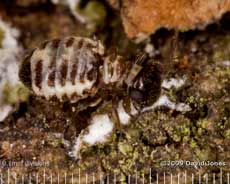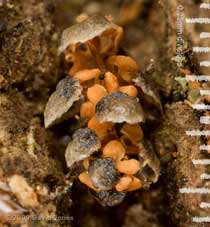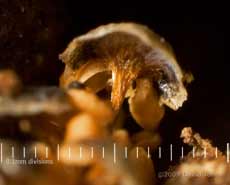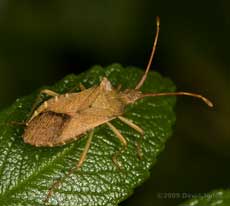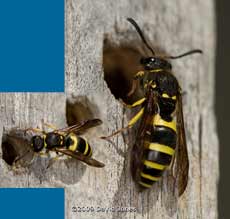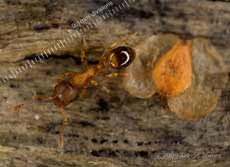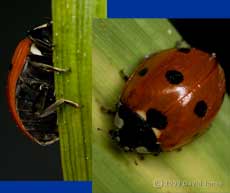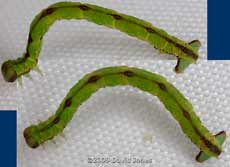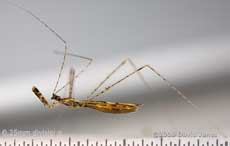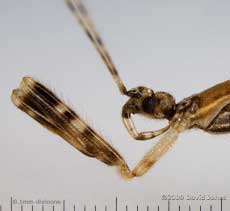Go to the last entry on this page .....Go to previous entry7 September - The month started with a largely wet day but since then it has certainly been autumnal, with cooler temperatures during the first week. The start of redecorating our hall was postponed a few days, but that got under way today, so we will now have a couple of weeks of disruption as the walls need some major TLC by the decorator. I spent a few days stripping all the walls before he started and needless to say I'll be taking it easy for the rest of this week!
In my last entry I included the cricket that I found in the bathroom. A couple of days ago I found another adult, this time a female Oak Bush Cricket, on a more expected place - a Birch leaf.
The Rosa rugosa produces simple, highly perfumed flowers which look great, although they last just two days, developing into large hips. I have already seen one that has clearly been pecked at by a bird. It's late in the season for flowers, but it looks as though we will have a few more before the end of Autumn. It will be interesting to see how much the plants grow by next Summer.
When the flowers open they are visited repeatedly by carder bumblebees. I haven't noticed any other species during the times when I watched.
There was a possible moment of shock-horror for a 'real' gardener a couple of days ago when I spotted this little caterpillar tucking into one of the roses' leaves. I can't be certain, but I think it is a young larva of a Dark Dagger moth (Acronicta tridens) - it can grow to 38mm before pupating before the end of Autumn.
Once disturbed it moved away and arched its back to emphasise the black hump on its fourth segment.
Looking from above, you can see that the red areas at the front are actually on either side of the black head,
and all the white patches are made up of tufts of hairs.
Back in November (8-10th) last year I took some photographs of what turned out to be a rare species of barkfly (Pseudopsocus rostocki).
He has identified the lichen as Melanelixia subaurifera, a ‘brown Parmelia’. He says that 'It is clearly grazing the upper part of the thallus (upper cortex and algal layer), leaving the white, cottony medulla exposed'. I haven't found any further examples of that species of barkfly although the other species that I find here seem to be doing well as this Autumn gets under way. I hope to get fresh logs supplies over the next couple of weeks so I shall be searching for interesting species once again.
This afternoon I spent a few minutes inspecting a few of the logs, but instead of choosing a barkfly to photograph I ended up focusing on what appears to be one of the smallest groups of gilled fungi that I've ever seen, in a crack on Oak bark. I should point out that the dark spheres that you may notice in the picture are barkfly droppings!
Looking again at the cap at the top of that first picture, this time from a different angle, I'm not so sure about tham having gills. This is as close as I can get without having to cut away the bark, and in the process very likely destroying the growth.
It seems that the fox may have moved on. While there continues to be night-time activity the camera is no longer recording the evening departures/morning returns that I reported on last month. Nevertheless the camera will continue to monitor that corner of the garden through the Autumn until I'm certain that the corner is no longer being used. At the bird feeders the Goldfinches seem to be increasing in numbers again now after a quiet summer. I haven't see the Sparrowhawk over the last week, although I found a flight feather on the ground here this morning - perhaps it met up with the Hawthorn! I'm only seeing (and hearing) the occasional Dunnock, and the only time I see a Blackbird is the rare glimpse at the bottom of the garden. Apples that I put under the Hawthorn a month ago have been completely ignored.
8 September - After a grey, and slightly damp start the clouds melted away and we had a sunny afternoon with the temperature reaching 25C. Work continues on our hallway, with the emphasis on sorting out the plaster of the walls and ceilings. A 1930's house, it suffers from a multitude of construction faults that make themselves known whenever you start redecorating! The aim is to have this stage in the process completed by Friday. I've added a second view of the fungus that I mentioned yesterday.
This is just the third time that I've seen this species here. Those sightings were in April 2006 and March 2007. This species was first recorded in the UK at Box Hill in Surrey some time before 1850. Since then it has been spreading, covering all corners of Surrey by 2002, and out to surrounding counties in recent years.
During cloudy August the bee hotels remained almost ignored so today it was refreshing to see this solitary wasp taking an interest. To give an idea of scale, the hole in the timber measures 7mm across. I believe that it may be Gorytes quadrifasciatus.
Back in March, during one of my barkfly sessions, I found some tiny ants living on and in a small Oak log. I added some photographs to the diary, and subsequently Bob Saville obtained an ID from an ant expert for me.
Here you can see one of the ants as it passed one of the millions of Birch seeds that are now to be found in every corner of the garden (and house!). And there are still a few barkflies on the log, which measures just 10x15x20cm, with bark on the largest side.
10 September - After a cool, cloudy day yesterday, with a sprinkling of rain from time to time, today was sunny, although still breezy and quite cool.
Just one insect photographed today, and a welcome one at that! This is the first ladybird of any type that I've seen here since July, and only the second Seven-spot Ladybird found in the garden this year (the first was in late June).
15 September - Over the last few days we have been plagued by quite chilly north-easterly breezes - I've been resorting to socks for the first time since early summer, and I've even needed to dig out a fleece! After a sunny day last Saturday (12th) it has turned increasingly cloudy, and this afternoon it is raining quite heavily. The downturn in the weather is a bit frustrating. My tree surgeon son has just had to cut down a couple of Oak trees and I was hoping to take a good look at the timber before it got wet. Unfortunately, my Discovery is receiving some TLC in a garage so won't available to bring some logs home until the middle of the week. However, I'm keeping my fingers crossed that the 'new' timber will provide some interesting discoveries in a few days time. In the meantime, just a couple of insects that I photographed after I held an up-turned umbrella under part of our Berberis bush as I shook some branches.
First, a looper caterpillar of unknown species, and measuring about 15mm in length.
The second insect is an assassin bug, probably Empicoris vagabundus, which I only come across very occasionally. In fact, the only previous records in the diary are from August 2006 (Birch tree) and October 2007, when I also found one in the Berberis.
Its long antennae look almost identical to the hind legs, even down to the 'joint' mid-way along them.
Here you can get a closer look at the raptorial legs, as well as the robust, 3-segmented rostrum or beak, curved back under the head when not in use.
As progress continues into the second week of work on our hallway the plastering is done, the new coving is up, and the walls and woodwork are being prepared. Enough has been done to allow us to start imagining how things will look, when we finally decide on the final paint colour for the walls! At least we have chosen the carpet.
Click on images to see larger version |
|
